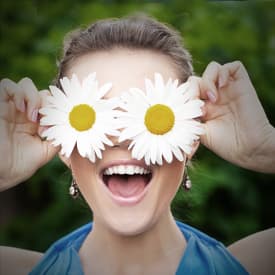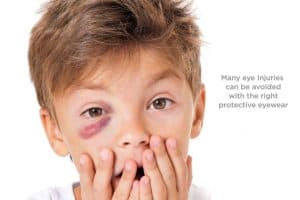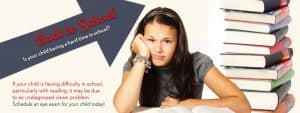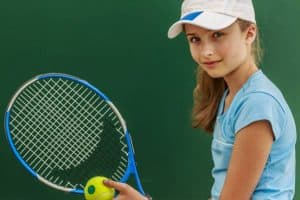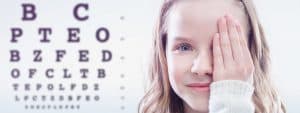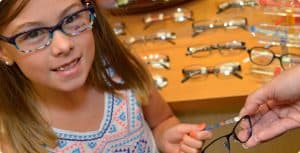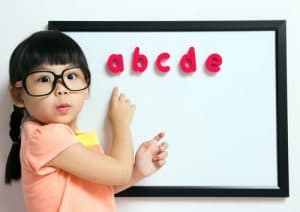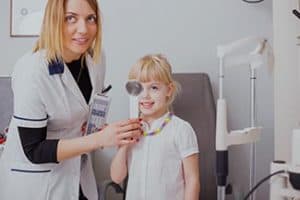Vision Problems and Babies: Part 2 Q&A
Eye exams are essential for babies to ensure normal visual development and to confirm there are no vision problems that might affect school performance. Here
Read MoreBabies and Vision Problems
Babies depend heavily on their vision to explore and learn about the world around them. Many people are unaware that vision, like walking and talking, is a learned ability and your baby’s eyes benefit from visual stimulation. That’s why it’s so important to make sure your child’s eyes and vision are developing normally.
Read MoreContact Lenses and Children: Part 2 Q&A
Did you know? Contact lenses can be safely worn by children aged 8 and up. Many times, parents are hesitant to get their child contact
Read MoreContact Lenses Safety for Children
Eye doctors report that over 4 in 10 of their contact lens patients are school aged children. According to the American Optometric Association (AOA), 14.5
Read MoreDoes my Baby have a Vision Problem?
Infant eye exams are essential to ensure your baby’s visual development meets their developmental milestones. Most baby’s eyes are assessed by a neonatologist within a
Read More2021 Update: Reading Comprehension
Since 80 percent of learning is through vision, if a child has a visual problem it will affect their reading comprehension. The first step in
Read MoreChildren’s Vision: FAQs
These are the 5 most frequent questions asked to eye doctors on children’s vision. You may easily find answers to your questions below. If you still have questions, contact your nearest eye doctor experienced in children’s vision.
Read More7 Common Pediatric Eye Conditions
Almost 20% of American children under 18 have a diagnosed eye or vision condition. Diagnosing eye problems in childhood can help minimize potential damage and makes treatment faster and more effective. That’s why parents should know about the most common pediatric eye problems and their symptoms.
Read MorePink Eye: What Do I Do?
If your child’s eyes are sore, scratchy or watery, they most likely have ‘Pink Eye’. Pink eye is the most common eye problem among children,
Read MoreTop 5 Pediatric Eye Emergencies
In the United States, approximately 380,000 patients per year are seen by emergency eye doctors. Over 33% are children requiring emergency eye care. While pediatric
Read MoreVisual Motor Integration
Does your child have difficulty with hand-eye coordination or playing sports? It could be a visual motor integration problem When a child incorrectly perceives the
Read MoreVisual Sequential Memory
Does your child struggle with reading or comprehension? It could be a visual sequential memory problem. The ability to remember the objects in a certain
Read MoreVisual Form Constancy
Does your child still reverse letters, numbers or words? It could be a visual form constancy problem. Form constancy is necessary to understand that
Read MoreVisual Figure Ground
Does your child struggle with copying words from the board? Or have difficulty finding important words in a text? It could be a visual figure-ground
Read MoreVisual Descrimination
Has your child been told they have a learning difficulty? It could be a visual discrimination problem. Visual discrimination is the ability to determine similarities
Read MoreVisual Closure
Does your child struggle with reading? Or have difficulty completing a puzzle? It could be a visual closure problem. The ability to quickly view parts
Read MoreVisual Memory
Does your child struggle with spelling or have comprehension difficulties? It could be a visual memory problem. The ability to remember what we see is
Read MoreSigns of Visual Processing Information Dysfunction
Is your child below grade level in reading, writing or even playing sports? It could be a sign of visual information processing dysfunction. A visual
Read MoreWhat Causes Low Vision In Children?
More than half a million children in North America are blind or have low vision. Having impaired vision makes it difficult to read, play sports,
Read More2021 Update: Writing and Spelling
Your child’s vision might be clear, but do they also have clear handwriting and accurate spelling? Vision is not just ‘20/20 sight’ but is also
Read More2021 Update: Parent’s Checklist for Vision Therapy
Does your child struggle in school and you’re not sure why? Up to 25 in every 100 children are affected by vision problems — that’s
Read More2021 Update: Vision Therapy for Learning
Research shows 25 percent of children have a significant vision problem that impacts their learning, according to the American Optometric Association (AOA). Up to 80 percent of all learning comes through the visual pathways. There are 17 visual skills that are necessary to perform at school and the office, these are all critical for learning.
Read More2021 Update: Vision Therapy for Visual Efficiency
Reduced visual efficiency can greatly reduce a student’s ability to learn or be an adult’s office productivity. Reduced visual efficiency can negatively impact a person’s
Read More2021 Update: Reading Fluency
80 percent of classroom learning is visual, meaning that any problems in the visual system can impact a child’s reading fluency. If a child has
Read More2021 Update: BVD and Dyslexia
Studies show that up to 15% of the population may be dyslexic, though less than 10 percent actually receive a formal diagnosis. Dyslexia is a complex condition that impacts the way the brain interprets and processes information. It is one of the most common learning disabilities that affects writing, spelling and reading.
Read MoreVision and Autism: Part 2
Author: Randy Schulman, MS, OD, FCOVD As vision is key to so many other systems, vision intervention, such as vision therapy, can have a profound
Read MoreVision and Autism: Part 1
Author: Randy Schulman, MS, OD, FCOVD This year marks my 30th year as an optometrist and during all of those years I have seen thousands
Read MoreCould Your Child Have Digital Eye Strain?
Since 2010, there has been a 70% increase of smartphone usage and 40% increase in laptop usage worldwide. Eye doctors are reporting a major increase
Read MoreAre Your Child’s Grades a True Reflection of their Potential?
Is your child struggling in school? They may have a vision condition that is affecting their ability to achieve academic success. When school becomes difficult
Read MoreCan you Improve your Child’s Academic Performance?
Did you know that 80% of the information you learn comes through your vision? If your child struggles to read or keep up with their
Read MoreWhat Are the Benefits of Vision Therapy?
Vision therapy is a structured program provided by highly trained and experienced optometrists. If you are considering vision therapy, it is important to understand the differences between programs offered by orthotists, occupational therapists and other healthcare practitioners.
Read MoreWhat are Retained Primitive Reflexes?
Primitive reflexes are essential for development of your baby’s brain. However, if these are ‘retained’ there could be consequences for your child. The foundation of
Read MoreMultifocal Contact Lenses for Children
Was your child prescribed multifocal contact lenses and you’re not sure why? Multifocal contact lenses are prescribed for children to support their learning and school
Read MoreVision Therapy or Occupational Therapy?
25% of all children have a vision problem significant enough to affect their performance in school. Parents will do almost anything to get their child
Read MoreScience Needs Compassion
Have you ever wondered if the smile of a nurse or the bedside manner of a doctor actually increase the chances of positive treatment results?
Read MoreLow Vision In Children
Many children suffer with vision loss, but there are a range of low vision aids that can give them the best chance to engage with the world around them. There are a number of conditions that can cause vision impairments in children. While some of these conditions can be treated in early childhood, many can result in low vision or even total blindness.
Read MoreContact Lenses for Astigmatism
Approximately 1 in 3 people have astigmatism, a vision condition that causes blurry and distorted vision. If you have astigmatism, there is a wide variety
Read MoreLazy Eye Success
Author: Dr. Randy Schulman EyeCare Associates, CT “Vision therapy has helped me ride my bike, and helps me for school in math, writing, and reading. I
Read MoreTinted Lenses for Color Blindness
An estimated 1 in 12 men and 1 in 200 women has some degree of color blindness. Color blindness is not an actual blindness, but
Read MorePink Eye or Allergies?
Do you find that you sometimes struggle to open your eyes due to severe eye discomfort? Eye allergy symptoms can sometimes mimic an eye infection,
Read MoreLazy Eyes Need Binocular Vision Therapy
Vision therapy has been shown to be the most effective solution for lazy eye, as it treats the underlying cause of the condition. A lazy
Read More“Lazy Eyes” Are Not Lazy
If a lazy eye is not really ‘lazy’, then what is it exactly? Lazy eye (amblyopia) is the most common neuro-developmental vision condition, affecting up
Read MoreWhich Frames Are Best for Playing Sports?
Sports-related eye injuries are one of the leading causes of visual impairment and vision loss among children in the United States.
Read MoreThe Larry Fitzgerald Story
Have you heard of NFL star Arizona Cardinals wide receiver, Larry Fitzgerald?
He is the second most career leading receiver for total TDs, yards, catches and more, after the legendary Jerry Rice. Larry credits his success on the field to a customized vision therapy program.
Help! My Child Dislikes Online Learning
The current COVID-19 pandemic has children learning through digital platforms for up to 7-10 hours a day! But what can you do when your child
Read MoreNear Point Visual Stress (NPVS)
Modern science now understands why long hours of reading and screen time can lead to eye strain. When the visual system struggles to meet the
Read MoreHow to Help Your Students Succeed
According to the American Optometric Association (AOA), 25 percent of all children have a vision problem significant enough to impact their learning. Up to 80
Read MoreMiSight Lenses for Myopia Management
MiSight contact lenses are daily disposable, soft contact lenses designed to control myopia progression in children ages 8 to 15 years. Although FDA approval is for children up to age 12, recent research has found that teens up to age 15 can also benefit from these lenses.
Read MoreOptical Lenses for Children
Which optical lenses are best for children? If you are purchasing new eyeglasses for your child, you may not even be aware that different lens options exist. While your optometrist will be able to guide you and recommend a specific type of lens for your child’s individual needs, it is a good idea to familiarize yourself with the different lens materials.
Read MoreProtecting Your Child From Digital Eye Strain
How does digital eye strain affect children? In recent years, there has been a significant surge in the amount of time children spend in front
Read MoreIs “20/20” Perfect Sight?
Author: Dr. Denise Smith The Center for Vision Development, Austin TX 20/20 vision is not ‘perfect sight’ Most people don’t think about vision until they
Read MoreVision Therapy for Math: Success Stories
Personal stories from adults and children who improved their math scores following Vision Therapy. *Names have been changed for privacy protection. Click here for a
Read MoreVision Therapy for Spelling: Success Stories
Real life stories of children with spelling difficulties, where an underlying visual problem was diagnosed and treated with Vision Therapy. *Names have been changed for
Read MoreVision Therapy: Success Stories
Real life stories of children with reading difficulties, where an underlying visual problem was diagnosed and treated by an eye doctor experienced in children’s vision. *Names have been changed for privacy protection.
Read MoreDoes Amblyopia (Lazy Eye) Affect Eye-Hand Coordination?
What is a lazy eye and how does it develop? Amblyopia, commonly known as lazy eye, is a neuro-developmental vision condition that begins in early
Read More8 Vision Therapy Myths and Facts
Vision therapy is a specialized program prescribed for the treatment of vision conditions that cannot be fully treated with eyeglasses or contact lenses. Unfortunately, there
Read MoreHow Can a Developmental Optometrist Help?
Developmental optometrists believe that vision can be developed and improved through a learned process. A developmental optometrist, also called a behavioral optometrist, focuses on the
Read MoreE-Learning Without Eyestrain: Part 2
Author: Dr. Nate Bonilla-Warford Bright Eyes Family Vision Care A visual health guide for students during the COVID-19 pandemic If your child is e-learning, and
Read MoreE-learning Without Eyestrain: Part 1
Author: Dr. Nate Bonilla-Warford Bright Eyes Family Vision Care A visual health guide for students during the COVID-19 pandemic If your child is experiencing screen-related
Read MoreThe Power of Visualization
Author: Dr. Lynn F. Hellerstein Hellerstein and Brenner Vision Center Visualization is an essential key to a child’s academic success. Does your child struggle in
Read MoreAnxiety Activated by Reflex Codes
Author: Dr. Alex and Patti Andrich The Vision Development Team If you frequently experience bouts of anxiety, you are not alone. According to the Anxiety
Read More5 Things Parents Should Know About Visual Development
Author: Dr. Ingryd Lorenzana Brain Vision Institute 1. The brain is the only organ that is not fully developed at birth, and its function builds
Read MoreSmart in Everything… Except School
Author: Dr. Denise Smith The Center for Vision Development, Austin TX Do you know a child who is smart in everything but school? These children
Read MoreVision Therapy and Children’s Vision: Books
Many parents request resources and names of books to help them to gain a deeper understanding of their children and to appreciate the benefits of
Read MoreWhat Are Prism Lenses?
Prism lenses can be effectively used to treat vision conditions, such as double vision and other binocular vision difficulties. One of the most common uses for an eye doctor to prescribe prisms is to treat a condition known as Binocular Visual Dysfunction (BVD).
Read MoreVision Therapy for “Laziness”: Success Stories
Personal stories from parents of children who were mislabeled as “lazy”, when a vision problem was the underlying cause. *Names have been changed for privacy
Read MoreDouble Vision (Diplopia)
Each year, approximately 850,000 visits to the doctor and emergency room are associated with double vision. Double vision, medically termed diplopia, can be very worrisome.
Read MoreWhat to Do for a Black Eye
What is a black eye? A black eye is medically termed a periorbital hematoma, or a collection of blood (hematoma) located in the tissues around
Read MoreHow Is Convergence Insufficiency Diagnosed?
Do you often lose your place while reading? Do words on the computer screen seem blurry? Do you suffer from frequent headaches or eye discomfort
Read MoreCan Glasses or Eye Patches Treat Convergence Insufficiency?
If you have been diagnosed with convergence insufficiency (CI), or are experiencing symptoms of CI, you may be wondering how CI is treated. Any type
Read MoreDyslexia FAQs
Q: What is dyslexia? A: Dyslexia is a complex condition that impacts the way the brain processes and interprets information. It is one of the
Read MoreConvergence Insufficiency FAQs
Q1: What is convergence insufficiency (CI)? A: Convergence insufficiency is a highly treatable binocular vision condition that affects near vision and eye muscle coordination. Convergence
Read MoreVision and Learning Difficulties FAQs
These are the ten most frequent questions asked to vision therapy eye doctors.
You may easily find answers to your questions. If you still have questions, contact your nearest eye doctor experienced in children’s vision and vision therapy.
Vision for Basketball
Many have dreamed of netting a 3 pointer the way Stephen Curry can— but did you know that strong visual skills are needed to land
Read MoreMyopia Management FAQs
Q1: What is myopia? A: Myopia is a refractive error, or a vision condition that affects the ability to see distant images or objects clearly.
Read MoreVision for Football
Did you know that Larry Fitzgerald, 11 times pro-bowl receiver of the Arizona Cardinals, attributes his success to vision therapy? Football is a sport in
Read MoreVision for Ice Hockey
Your visual skills can affect your ice hockey performance. Wayne Gretzky, known as the “The Great One”, is the leading scorer in NHL history, with
Read MoreVision for Soccer
Soccer skills are dependent on your physical stamina, legs and feet … and also your eyes. Soccer is played in over 200 countries, making it
Read MoreVision for Tennis
Tennis players need speed, endurance, flexibility, and agility to be successful in the game. Did you know that tennis players also need excellent visual skills?
Read MoreVision for Golf
Strong visual skills are vital for optimal golf performance— from seeing your target, reading a putt, and even visualizing your swing? Your ability to play
Read MoreVision for Baseball
If you think that hitting that 100 mile per hour fastball out of the park is all about athletic genes or natural abilities, what you
Read MoreWhat Are Contact Lenses?
Contact lenses are designed to cover the cornea, the clear covering of the eye. They stay in place by adhering to the tear film of the eye, and through the pressure from the eyelids. When you blink, your eyelid glides over the contact lens, enabling a cleansing and lubricating action to keep the contact lens comfortable on the cornea.
Read MoreGuide to Dry Eye
Do suffer with dry eyes? There are a range of very successful treatment now available that can offer you significant relief from your symptoms. The key is receiving the right diagnosis and appropriate advice from your eye doctor.
Read MoreOptical and Contact Lenses
Buying your new pair of eyeglasses can be fun. The quality and range of lenses are always increasing. Considering contact lenses or laser surgery?
Read MoreEyes and Nutrition
How does nutrition impact ocular health? A balanced diet should provide all the nutrients required for optimum eye health. Nutrients are vital for healthy eyes. Many nutrients help to support eye function, and serve as protection against harmful light. In this way, nutrients may reduce the risk of age-related degenerative ocular diseases that can put your vision in danger.
Read MoreEyecare for Children
Eyecare for Children Are you worried about your child needing glasses? Do you want to understand why your child needs bifocals or multifocals? Are you
Read MoreVision for School
Is your child not reaching their potential at school? For a child to succeed in school they need excellent vision and strong visual skills, including eye tracking, focusing, binocular vision and visual processing. These skills can be enhanced with the correct eyewear and vision therapy.
Read MoreVision Therapy for Lazy Eye
Lazy eye is a common vision problem, affecting up to 1 in 20 (5%) of all children. Has your child been treated for lazy eye, yet the vision remains poor? Lazy eye can be successfully treated for both children and adults, with new digital techniques using computer-based 3D games.
Read MoreVision Development and Milestones
It is important to watch your baby’s development to ensure they reach their milestones. A child’s vision is a complex combination of the brain, the eyes and the vast array of nerves that connect them. At birth, this visual system is still immature and continues to develop throughout the child’s early years.
Read MoreDo Children Need Sunglasses?
We all appreciate the need to protect our skin and eyes from harmful ultraviolet (UV) radiation— this is even more important for children! Your child’s
Read MoreA Guide to Eye Infections
Up to 1 in 8 of all children will have an eye infection each year. Parents should be aware of the symptoms of an eye infection to enable prompt identification and treatment. Eye infections can be serious and may cause permanent vision loss. Effective treatment is always needed, especially when bacteria, viruses, or fungi invade the eye or the surrounding areas. The most common eye infections that affect children are called Viral and Bacterial Conjunctivitis— both highly contagious.
Read MoreWhat Is Myopia?
Myopia affects clarity of vision for any distant images and objects – the board in a classroom, driving, the television, a clock on the wall, etc. Myopia affects millions of children and adults, worldwide, over 30% of the U.S. population suffers from myopia.
Read MoreConvergence Insufficiency
Convergence Insufficiency (CI) impacts the lives of up to 15% of all students. This is a highly treatable binocular vision condition that affects near vision and eye muscle coordination.
Children with CI can be mislabeled as ‘lazy’, ‘clumsy’, ‘poor students’ and ‘anxious’, or even misdiagnosed with ADHD and dyslexia.
Choosing Glasses for Children
A guide to choosing the best eyeglasses for your child. Eyeglasses for children are now fun, colorful, and available in a wide variety of shapes and sizes. The latest children’s frames are also durable enough to survive the rough and tumble play of today’s child. With so many appealing choices, walking into an optical store can be quite overwhelming … remember to keep this experience as fun and relaxed as possible!
Read MoreNAACP: Vision and Learning Statement
NAACP Passes Resolution on Vision, Learning, and High-Risk Populations at its 100th Anniversary National Convention, New York, NY 2009 PR Newswire, September 29, 2009 Charles
Read MoreDoes My Child Have Dyslexia?
Has your child been diagnosed with Dyslexia? Since up to 80 percent of learning in school is acquired through vision, a child diagnosed with dyslexia may actually have an undiagnosed vision problem, causing difficulties with their academic performance.
Read MoreEye Exams for Children
Eye doctors utilize specific clinical and diagnostic tools and assessments to determine your child’s eye health and visual abilities. Since many learning skills are dependent on the strength of visual skills such as binocular vision, accurate eye movements, the ability to see distant objects, etc., doctors recommend that children have their first eye exam at age 6 months.
Read More